Family: Tenthredinidae
Family common name: common sawflies
Subfamily: Blennocampinae
Tribe: Phymatocerini
Genus: Rhadinoceraea Konow, 1886
Subgenera: Rhadinoceraea, Veratra
The Tenthredinidae are the most species-rich family and are found throughout the world, in all continents but Antarctica. They are known as the “common sawflies.” They can generally be recognized by a cylindrical body and long, segmented antennaeantenna:
the sensory organ emerging from the front of the head, usually between the compound eyes and above the clypeus; includes the flagellum, scape and pedicel
 . Otherwise, they come in a variety of colors, sizes, and forms (Goulet 1992Goulet 1992:
. Otherwise, they come in a variety of colors, sizes, and forms (Goulet 1992Goulet 1992:
Goulet H. 1992. The genera and subgenera of the sawflies of Canada and Alaska: Hymenoptera. Symphyta. The insects and arachnids of Canada. Part 20. Agriculture Canada Publication.).
Sawflies in the subfamily Blennocampinae have a diverse set of life histories and habits. Many species are restricted to subtropical and tropical regions, but the genus is still fairly species-rich in North America. Blennocampinae includes many sawflies that feed on ornamental and forestry crops. This subfamily can be recognized by wing venationvenation:
the network of veins on a wing
and bidentatebidentate:
having two teeth; often used in descrbing mandibles or tarsal claws
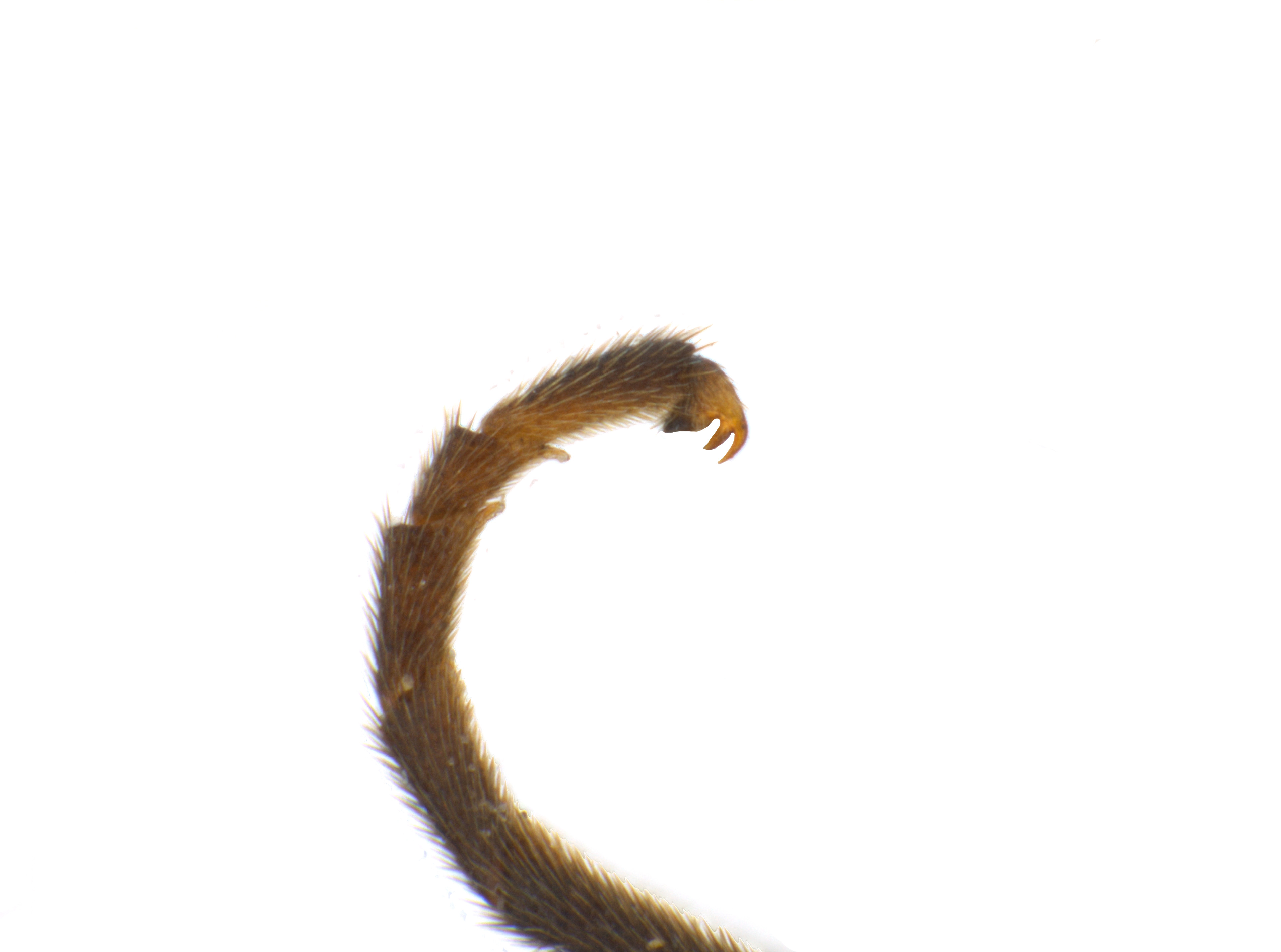 mandibles (Smith 1969dSmith 1969d:
mandibles (Smith 1969dSmith 1969d:
Smith DR. 1969d. Nearctic Sawflies. I. Blennocampinae: Adults and larvae (Hymenoptera: Tenthredinidae). Technical Bulletin, U.S. Department of Agriculture 1397: 1-176.).
Rhadinoceraea are medium-sized, about 6–8 mm in length, and almost entirely black with darkened wings (Smith 1969dSmith 1969d:
Smith DR. 1969d. Nearctic Sawflies. I. Blennocampinae: Adults and larvae (Hymenoptera: Tenthredinidae). Technical Bulletin, U.S. Department of Agriculture 1397: 1-176.).
There are 19 described extantextant:
in existence; opposite of extinct
species worldwide. Ten species occur in North America (Taeger et al. 2010Taeger et al. 2010:
Taeger A, Blank SM, and Liston AD. 2010. World Catalog of Symphyta (Hymenoptera). Zootaxa 2580: 1-1064.).
A key to North American species is included in Smith 1969dSmith 1969d:
Smith DR. 1969d. Nearctic Sawflies. I. Blennocampinae: Adults and larvae (Hymenoptera: Tenthredinidae). Technical Bulletin, U.S. Department of Agriculture 1397: 1-176..
Subfamily characters
 veins Cu1 and 1m-cu between 120°–150° (Goulet 1992Goulet 1992:
veins Cu1 and 1m-cu between 120°–150° (Goulet 1992Goulet 1992: veins M and 1m-cu parallel (Smith 1969dSmith 1969d:
veins M and 1m-cu parallel (Smith 1969dSmith 1969d: veins 2A and 3A incomplete (Smith 1969dSmith 1969d:
veins 2A and 3A incomplete (Smith 1969dSmith 1969d:Genus characters
 veins 2A and 3A forked at apexapex:
veins 2A and 3A forked at apexapex: cellcell:
cellcell: M present (Smith 1969dSmith 1969d:
M present (Smith 1969dSmith 1969d: basalbasal:
basalbasal: simple or with short inner tooth (Smith 1969dSmith 1969d:
simple or with short inner tooth (Smith 1969dSmith 1969d: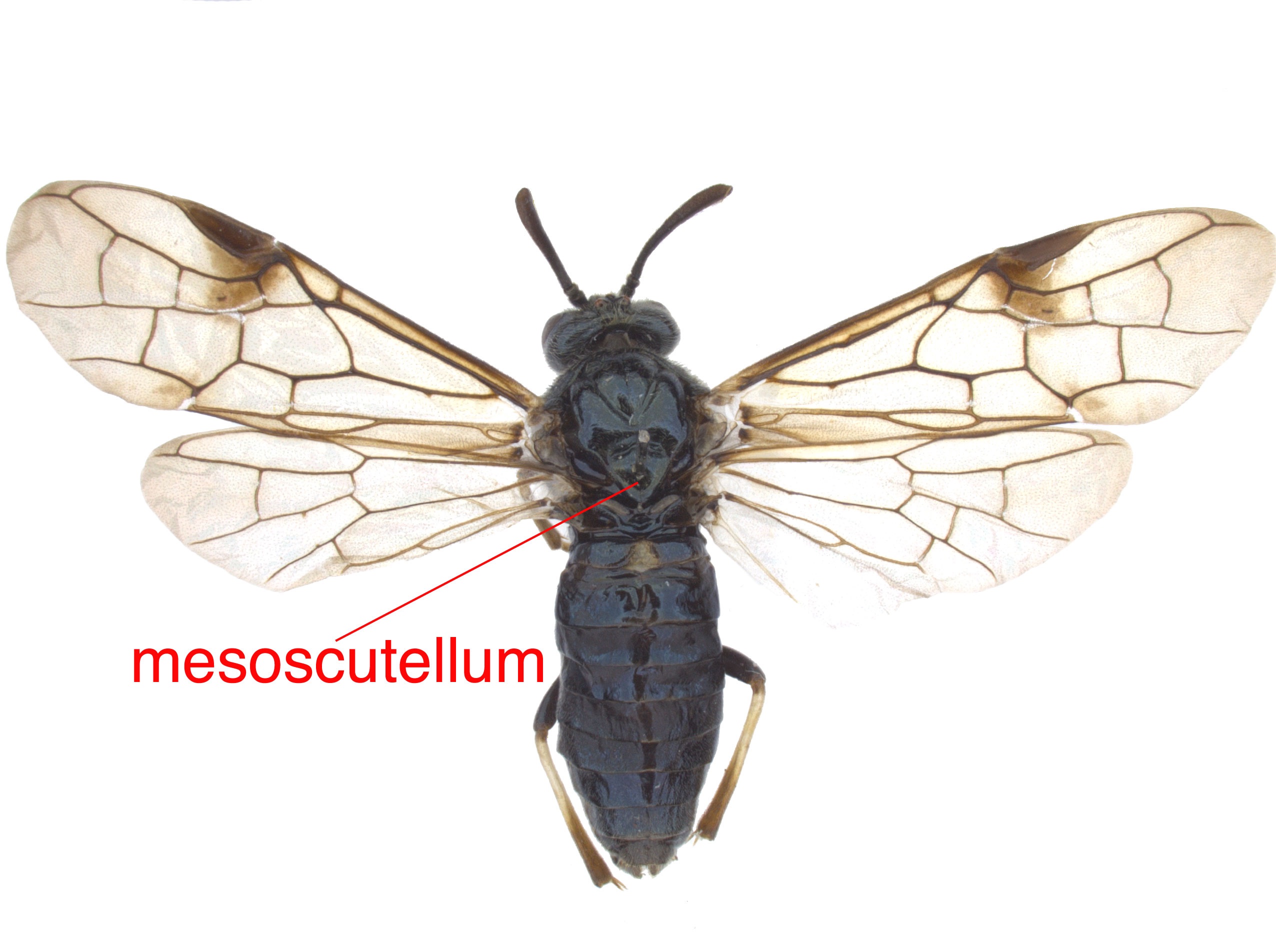 or mesepisternummesepisternum:
or mesepisternummesepisternum: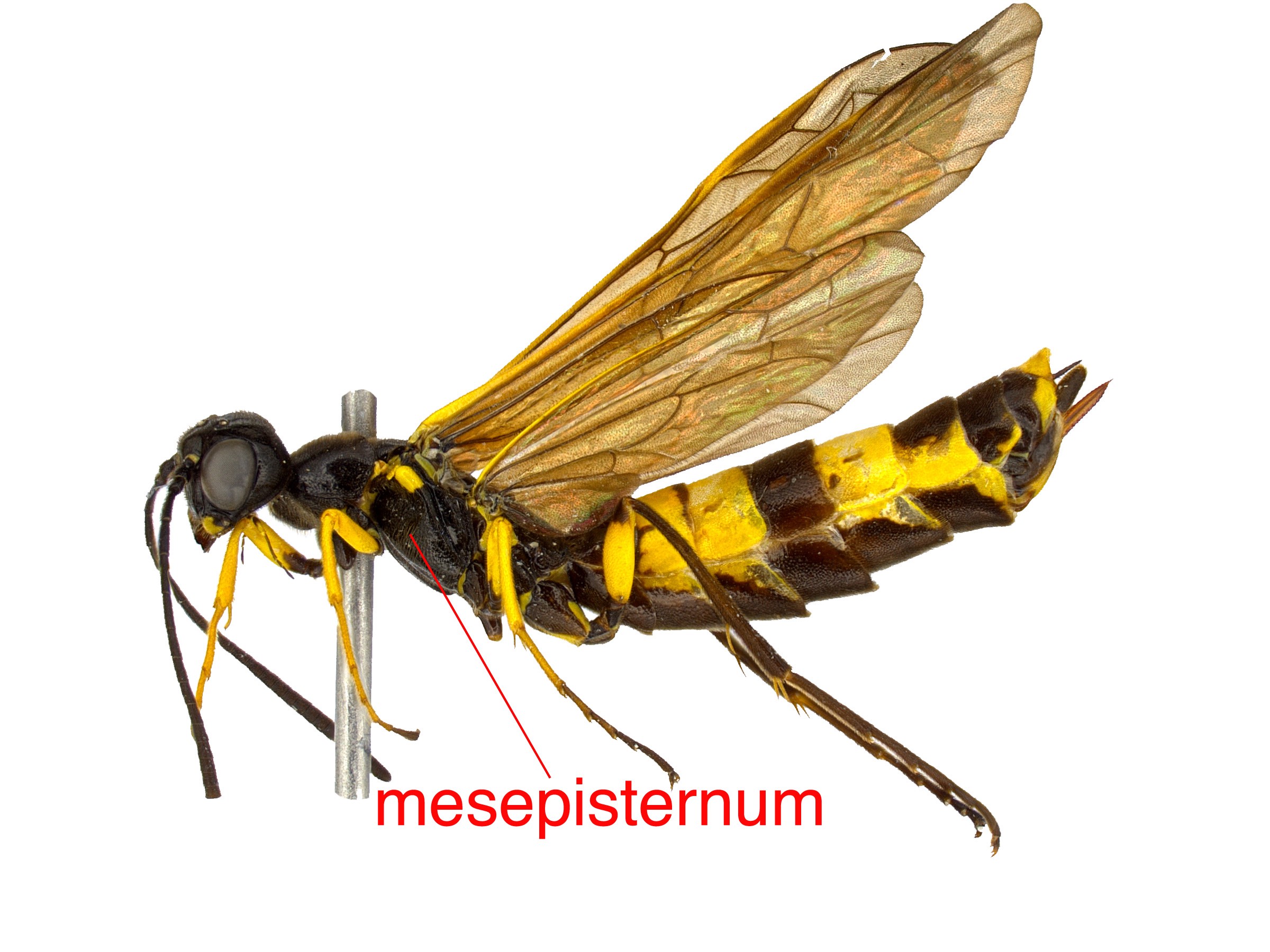 (Goulet 1992Goulet 1992:
(Goulet 1992Goulet 1992: (Goulet 1992Goulet 1992:
(Goulet 1992Goulet 1992:Rhadinoceraea can be confused with similar species in the subfamily Blennocampinae. It can be distinguished from most other genera by the developed pulvillipulvillus:
soft pads used for surface adhesion, located in sawflies on the first 4 segments of the tarsus
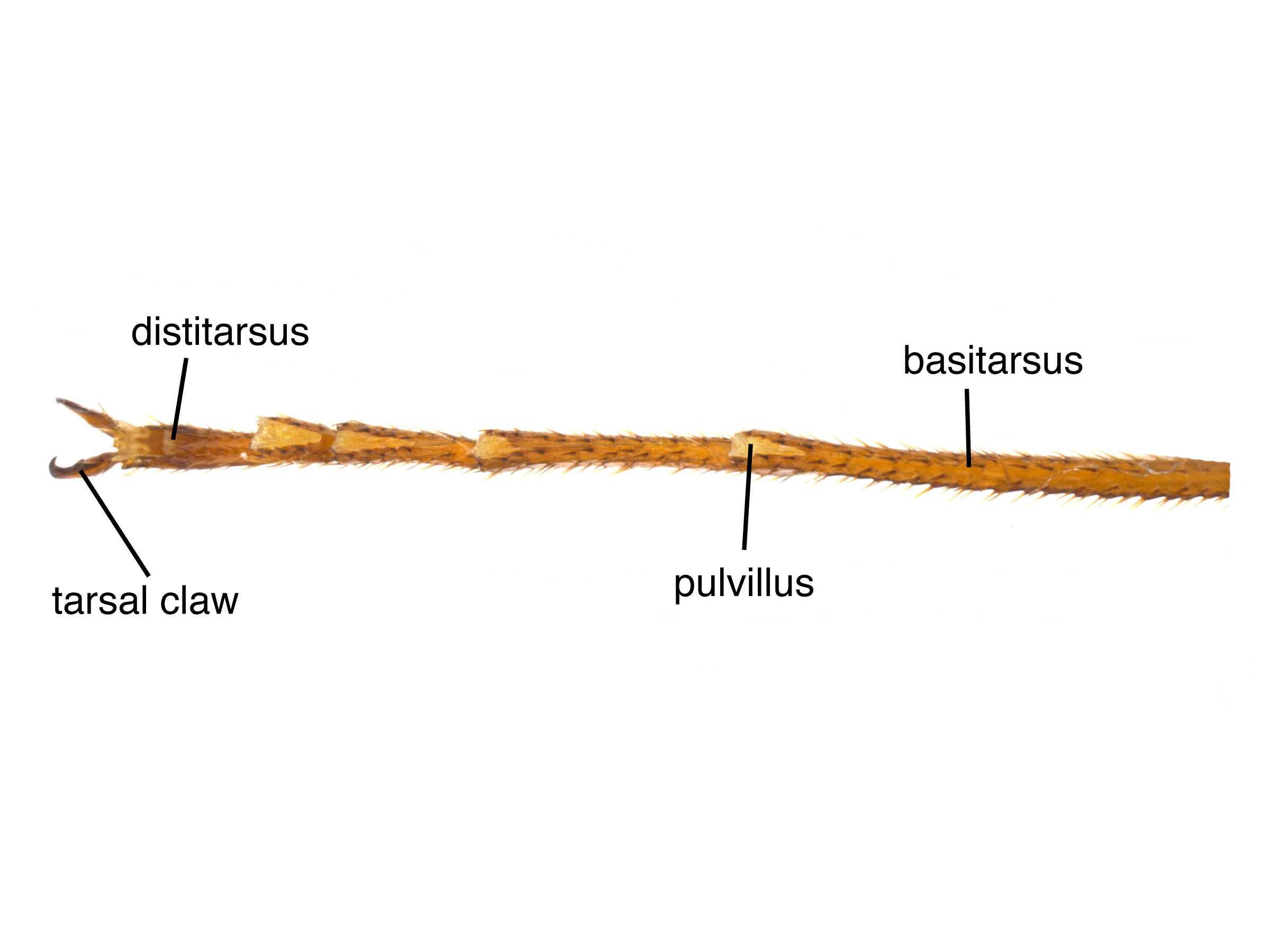 on basalbasal:
on basalbasal:
towards the base; closest to the body
tarsomeres and the furcatefurcate:
divided into branches; forked
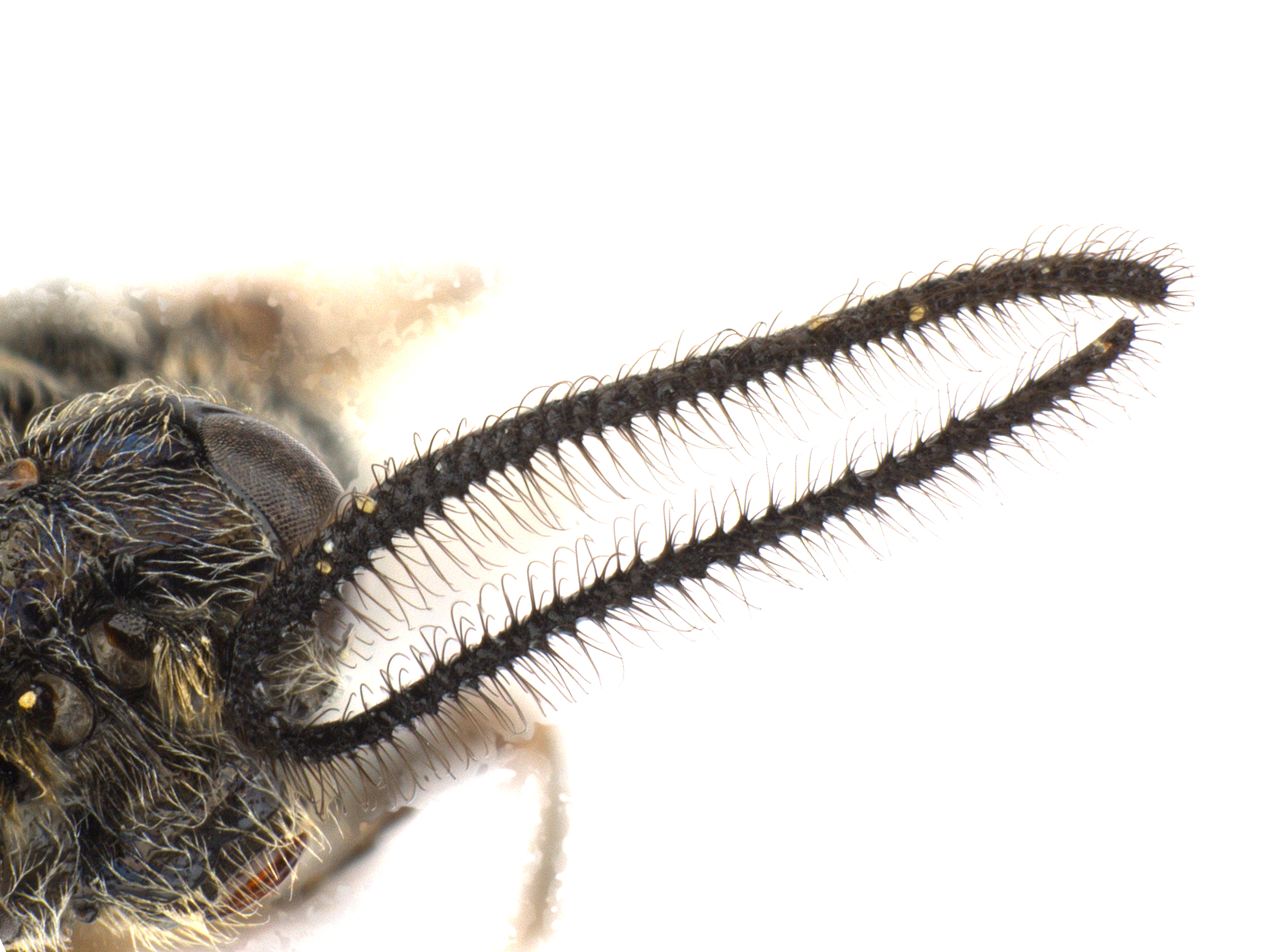 apexapex:
apexapex:
the end or most distal area of any structure
to veins 2A and 3A of fore wingfore wing:
the anterior wing of each pair of wings; usually the largest wing of the pair
 . Rhadinoceraea can be distinguished from similar species in Phymatocera and Paracharactus by the short mesoscutellar appendagemesoscutellar appendage:
. Rhadinoceraea can be distinguished from similar species in Phymatocera and Paracharactus by the short mesoscutellar appendagemesoscutellar appendage:
the rounded, central dorsal appendage emerging posteriorly form the mesoscutellum
(Smith 1969dSmith 1969d:
Smith DR. 1969d. Nearctic Sawflies. I. Blennocampinae: Adults and larvae (Hymenoptera: Tenthredinidae). Technical Bulletin, U.S. Department of Agriculture 1397: 1-176.).
Sawflies of this genus are generally not considered pests. The poisonous plants that serve as their host are often a nuisance to livestock farmers, and thus Rhadinoceraea has potential use as biocontrol for these dangerous plants. Rhadinoceraea nodicornis, for example, is monophagous in Europe on Veratrum album (white false hellebore) and is being considered as a biocontrol agent due to this specificity (Schaffner et al. 2001Schaffner et al. 2001:
Schaffner U, Kleijn D, Brown V, and Muuml;ller-Schauml;rer H. 2001. Veratrum album in montane grasslands: a model system for implementing biological control in land management practices for high biodiversity habitats. Biocontrol News and Information 22 (1): 19-28.).
In North America, Rhadinoceraea feeds on Calochortus, Stenanthium densum (crowpoison), Veratrum viride (green false hellebore), Veratrum californicum (California false hellebore), and other species of Veratrum (false hellebore) (Smith 1969dSmith 1969d:
Smith DR. 1969d. Nearctic Sawflies. I. Blennocampinae: Adults and larvae (Hymenoptera: Tenthredinidae). Technical Bulletin, U.S. Department of Agriculture 1397: 1-176., Smith and McDearman 1990Smith and McDearman 1990:
Smith DR and McDearman W. 1990. A new Rhadinoceraea (Hymenoptera, Tenthredinidae) feeding on Zigadenus (Liliaceae) from southeastern United States. Entomological News 101 (1): 13-19., Goulet 1992Goulet 1992:
Goulet H. 1992. The genera and subgenera of the sawflies of Canada and Alaska: Hymenoptera. Symphyta. The insects and arachnids of Canada. Part 20. Agriculture Canada Publication.).
Female R. aldrichi oviposit into small chambers they create on the underside of the leaves in short rows parallel to the main veinvein:
a tube-like, often darkened, structure on the wings
 . After hatching, larvaelarva:
. After hatching, larvaelarva:
the immature stage of holometabolous insects
 feed on the leaf tissue leaving small, irregular holes (Smith 1969dSmith 1969d:
feed on the leaf tissue leaving small, irregular holes (Smith 1969dSmith 1969d:
Smith DR. 1969d. Nearctic Sawflies. I. Blennocampinae: Adults and larvae (Hymenoptera: Tenthredinidae). Technical Bulletin, U.S. Department of Agriculture 1397: 1-176.).
Two species, R. zigadenusae and R. sodsensis, share an uncommon larval habit of feeding on flower parts. Females deposit eggs singly into the stalks of flower inflorescences. Young larvaelarva:
the immature stage of holometabolous insects
 burrow into the flower buds to feed on the immature stigmastigma:
burrow into the flower buds to feed on the immature stigmastigma:
a section of the fore wing at the apex of vein C that is sclerotized, rounded and often darkened
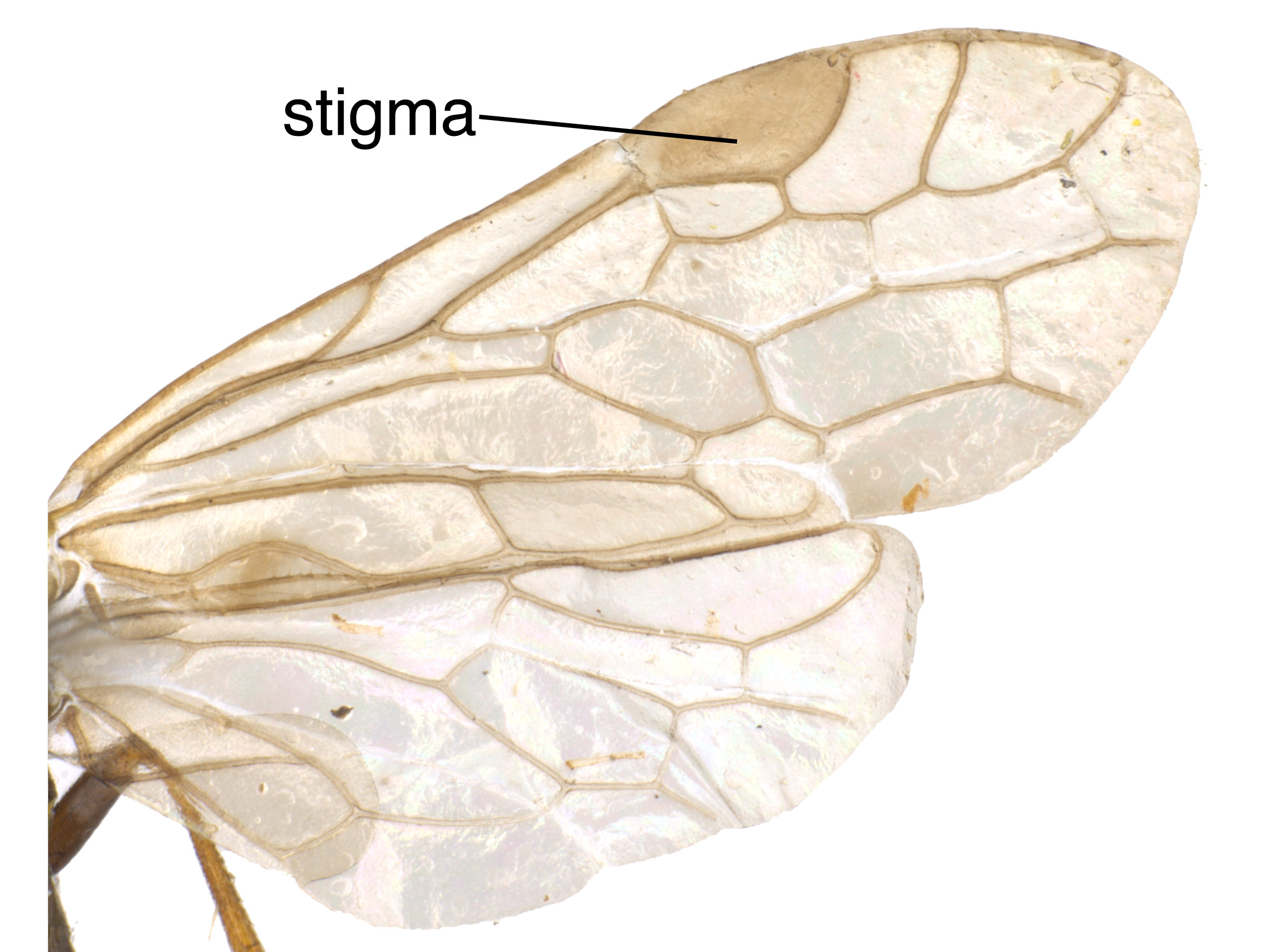 and stamen, and as they develop move to feeding on mature flowers and fruits. These species are univoltineunivoltine:
and stamen, and as they develop move to feeding on mature flowers and fruits. These species are univoltineunivoltine:
describing an insect with a life cycle of one generation per year
(Smith and McDearman 1990Smith and McDearman 1990:
Smith DR and McDearman W. 1990. A new Rhadinoceraea (Hymenoptera, Tenthredinidae) feeding on Zigadenus (Liliaceae) from southeastern United States. Entomological News 101 (1): 13-19., Smith and Barrows 1995Smith and Barrows 1995:
Smith DR and Barrows EM. 1995. Rhadinoceraea n. sp. (Hymenoptera: Tenthredinidae) from West Virginia, a second species on Zigadenus (Liliaceae). Entomological News 106 (5): 237-240.).
Several of the host plants of Rhadinoceraea are toxic. European species R. nodicornis is documented sequestering alkaloids from its host plant into the hemolymphhemolymph:
the "blood" of an insect, a fluid plasma containing nucleated cells
. Combined with the larval habit of “easy-bleeding,” a behavior that is also present in R. micans, the toxic hemolymphhemolymph:
the "blood" of an insect, a fluid plasma containing nucleated cells
is used as a predation defense (Barker et al. 2002Barker et al. 2002:
Barker AM, Schaffner U, and Boeveacute; JL. 2002. Host specificity and host recognition in a chemically-defended herbivore, the Tenthredinid sawfly Rhadinoceraea nodicornis Entomologia Experimentalis et Applicata 104: 61-68., Voigt et al. 2011Voigt et al. 2011:
Voigt D, Gorb S, and Boeveacute; JL. 2011. Superhydrophobic cuticle with a ldquo;pinning effectrdquo; in the larvae of the iris sawfly, Rhadinoceraea micans (Hymenoptera, Tenthredinidae). Zoology 114(5): 265-271. https://doi.org/10.1016/j.zool.2011.05.004). These accounts suggest that these defensive behaviors may be shared by North American species.
World: This genus is known from North America, Central and Eastern Europe, through Russia, and in China (Taeger et al. 2018Taeger et al. 2018:
Taeger A, Liston AD, Prous M, Groll EK, Gehroldt T, and Blank SM. 2018. ECatSymmdash;Electronic World Catalog of Symphyta (Insecta, Hymenoptera). Program version 5.0 (19 Dec 2018), data version 40 (23 Sep 2018). Senckenberg Deutsches Entomologisches Institut (SDEI), Muuml;ncheberg. https://sdei.de/ecatsym/ Accessed: 28 Jan 2020.).
North America: Rhadinoceraea is a mostly western genus. Species of the subgenus Rhadinoceraea occur in southern California and in Utah. The majority of the subgenus Veratra occurs throughout the Pacific coast from California to Alaska and east into Idaho and Alberta. Some species have eastern ranges: R. nubilipennis occurs east of the Appalachian mountains from North Carolina north into Quebec (Smith 1969dSmith 1969d:
Smith DR. 1969d. Nearctic Sawflies. I. Blennocampinae: Adults and larvae (Hymenoptera: Tenthredinidae). Technical Bulletin, U.S. Department of Agriculture 1397: 1-176.), and R. zigadenusae and R. sodsensis occur south in West Virginia, North Carolina, Mississippi, and Alabama (Smith and McDearman 1990Smith and McDearman 1990:
Smith DR and McDearman W. 1990. A new Rhadinoceraea (Hymenoptera, Tenthredinidae) feeding on Zigadenus (Liliaceae) from southeastern United States. Entomological News 101 (1): 13-19., Smith and Barrows 1995Smith and Barrows 1995:
Smith DR and Barrows EM. 1995. Rhadinoceraea n. sp. (Hymenoptera: Tenthredinidae) from West Virginia, a second species on Zigadenus (Liliaceae). Entomological News 106 (5): 237-240.).
Map data from: GBIF.org (29 October 2019) GBIF Occurrence Download Rhadinoceraea
Details about data used for maps can be found here.